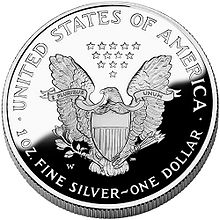Silver coin
As silver is known coins whose silver content ( purity ) greater than 50 percent of the Raugewichts is. If the silver content is less than 50 percent, one speaks of a billon coin .
The base alloy component used to be mostly copper , which made the coin harder. A pure silver coin would have been too soft for circulation and would have been severely rubbed off after a short period of circulation.
Silver coins were the days of the silver standards often Kurantmünzen , but partly also Coinage reduced monetary standard . Since around 1970 silver coins have disappeared from circulation worldwide as normal course coins . Today's 10 euro silver coins are legal tender in their country of issue, but as commemorative coins they are mainly designed for collectors.
Silver coins for investments are offered in small denominations as bullion coins (such as the Vienna Philharmonic , American Silver Eagle , Maple Leaf ) and in large denominations in the form of coin bars .
End of silver course coins by country
From the introduction of coinage in antiquity until after the Second World War, most of the medium-value coins were silver coins. Change consisted of copper and low-alloy silver alloys; the high denominations of gold. Denmark and Norway were the first countries to stop using silver coins (during the First World War). Many other countries followed during or shortly after World War II (e.g. United Kingdom ), while Switzerland in 1969, Austria in 1973 and (as one of the last countries in the world) the Federal Republic of Germany in 1974 followed. France stopped issuing silver coins in 1969, Italy and Spain in 1970, while the USA withdrew as early as 1964/65.
The disappearance of the last silver coins from everyday payment transactions had various reasons at the beginning of the 1970s. That was when the oil crisis , the collapse of the Bretton Woods system , strong inflation in many industrialized countries and an increasingly volatile silver price came together. This made it difficult to plan the issue of silver coins. In particular, there was a risk that the material value of the coins would exceed their imprinted face value. Ultimately, the use of coins containing appreciable precious metals was not compatible with a rather expansive central bank policy , which plans annual currency devaluation ( inflation ) as a target.
From a technical point of view, silver coins are not safe from vending machines. Different copper-nickel alloys are better suited here, as they have a precisely defined magnetism . This makes fraud through the use of unintended, inferior coins more difficult.
The following is an overview of the last silver course coins in everyday use in some countries:
|
|






